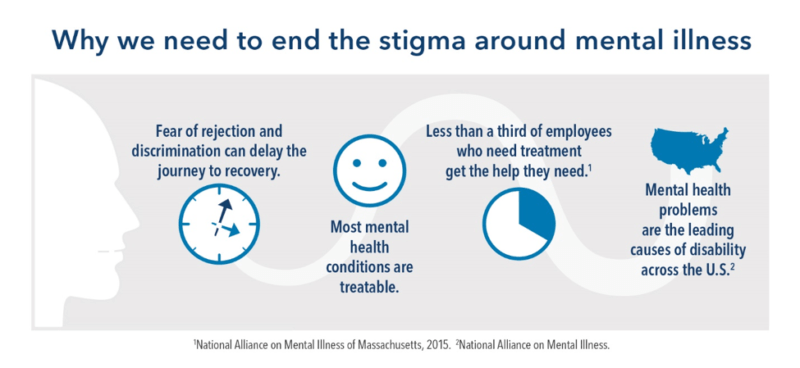Mental Health in the Workplace
Mental health awareness has exploded over the last five years. Online digital media publications have dedicated a lot of content—and rightfully so—to this once-taboo subject because of the large appetite from readers wishing to overcome the barriers that really affect how we live. One area, however, that has stayed behind the curve regarding these important discussions, is the workplace. Social stigma in discussing facets of not only our mental health but also our emotional health persists in the workplace among employees and supervisors. This is understandable; no employee wants to give the impression they are overwhelmed or that they cannot handle the job’s responsibilities, nor do they want to feel belittled or treated differently due to a personal issue. Supervisors may feel awkward or unqualified to address mental health concerns, or they may be worried that they will say or do the wrong thing and create an HR issue.
And yet, mental health issues in the workplace have an extraordinary global economic impact. According to a September 2017 report conducted by the World Health Organization (WHO), mental health costs the global economy an estimated US$ 1 trillion per year in lost productivity. Disturbances to our mental and emotional well-being affect our ability to do our jobs properly and efficiently. This, in turn, affects an organization’s time, resources, and eventually the bottom line.
Organizations have tried to indirectly combat mental health in the workplace by offering office perks intended to make the workplace more fun and inviting, like free food, game rooms, and other benefits. But while ping-pong tables and soda fountains do make office life more amusing, they don’t provide the mental health support that’s truly lacking.
The Center for Prevention and Health estimates that mental illness and substance abuse issues cost employers between $79 and $105 billion each year in the United States alone. Instead of looking for shiny things to keep employees distracted from the reality of office life, organizations should focus on setting the right culture of support first, then find out what extra perks their employees specifically want.
One in five Americans has a diagnosable mental health condition, and this alone is striking enough for business leaders and organizations to act. Promoting good mental health could be one of the best ways to improve an entire organization. It may not outright prevent anxiety from occurring, but making an established known effort and opening lines of communication can provide some reassurance for employees that support does indeed exist.
Here are ways business leaders and organizations can break through some of those barriers.
Four Mental Health Initiatives for the Workplace:
1. Mental Health Days
Organizations often lump personal days and vacation days together. Personal days are just that; they could be spent catching up on family time, running much-needed errands, or even sleeping in. A first step to breaking through the stigma of mental health is to separate those days. Personal days should also include specific references to mental health; for HR professionals, this could be accomplished simply by explaining how much the organization values employees’ emotional well-being. A simple change in terminology could accomplish even more: Giving employees mental health days makes the intent clear, and is especially inclusive of those employees who may be considering (or already are seeking) professional treatment.
2. Ensuring Emotional Well-Being is a Priority
A lot of health plans offer incentives and credits to employees for achieving wellness goals, like quitting smoking or attending fitness classes, but things like healthy eating, exercise, and team-building activities are even better coming from inside the office. Organizations that reinforce these goals by offering their own incentives are not only improving their chances of having fitter, healthier employees; they’re also creating a cultural platform that improves their image internally and externally. Some organizations have even reported including a financial credit as employees hit their health goals.
3. Providing On-Campus Treatment
This may be a more feasible option for larger, more established organizations, but having a trained professional on-site would provide significant benefits to employees needing readily accessible assistance. This would also benefit those who need professional help but have not been able to seek it for various reasons, like time or distance. So long as they are treated with the utmost confidentiality, on-site treatment sends a message to employees that their well-being is truly valuable.
4. Establishing Open Communication between Management and Employees
Lastly, but perhaps most importantly, scheduling regular check-ins and encouraging thoughtful discussion is critical to establishing the trust and communication vital to positive workplace culture. This can be a fine line for managers to walk, but with proper training, they can be shown the benefits of simply getting to know their employees on an individual level and watching for signs of change that could prompt discussion. Not to mention, proactively welcoming employees to discuss mental health topics breaks down the stigma associated with them.
With managers learning more and understanding their employees better, they can open lines of communication that bring unknown issues into the light, and by doing so, find solutions while building trust and loyalty.
The key here is to reassure employees that no judgment will be passed; while it’s illegal in most cases to even talk about, much less terminate or demote an employee for revealing a mental health issue, it’s still a very real risk for people that they will be seen differently by their peers and superiors. Organizations can provide reassurance and encouragement by being transparent about manager training around mental health, and by clearly communicating (and demonstrating) their policies and values.
Emotional Health Boosts Employee Engagement
In a 2015 research study conducted by the National Alliance on Mental Illness of Massachusetts, fewer than one in three employees who struggle with a mental health condition reported receiving the help they need.
Furthermore, the report states that 62% of missed work days have been attributed to mental health conditions. These statistics alone would seem to suggest the possible advantages of providing support for employees suffering from mental health issues, but the advantages become clear when it’s reported that more than 80% of employees who received treatment felt much better about their jobs and organizations overall. Clearly, organizations that make an effort to address mental health—even if it’s simply by establishing a culture of support and encouragement for employees—are doing something positive for themselves as well as their people. And if employees who receive treatment report higher job satisfaction, directly providing assistance in the form of wellness initiatives and on-site treatment might even foster greater productivity and performance.
Establishing that culture is the first and most important step, however, and the example must be set from the top. Business leaders, including CEOs, human resources professionals, and executives are responsible for creating, communicating, and demonstrating the culture they want their managers and employees to embrace. Without this leadership, there can be no assurance that any of these subjects will be destigmatized, and the hurdles associated with acknowledging and treating mental health issues will remain in place.

About the Author
 Ahmed Muneeb is a Content Strategist who partners up with startup founders, solopreneurs and businesses to provide thought-leadership content and market research. He is passionate about sustainability, promoting overall well-being and efficient organizational management. He is also a published writer and has been featured on Thrive Global, Thought Catalog and The Good Men Project. He is also a co-founder of the 1M1L project, dedicated to charging towards a more sustainable future.
Ahmed Muneeb is a Content Strategist who partners up with startup founders, solopreneurs and businesses to provide thought-leadership content and market research. He is passionate about sustainability, promoting overall well-being and efficient organizational management. He is also a published writer and has been featured on Thrive Global, Thought Catalog and The Good Men Project. He is also a co-founder of the 1M1L project, dedicated to charging towards a more sustainable future.
Get caught up every month on all things HR. Don't worry, we promise we won't spam you.









